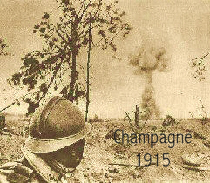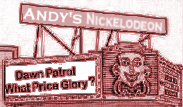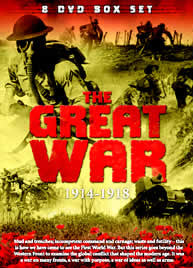
September 2005 |
Access Archives |
|
TRENCH REPORT: Big news from the Great War Society this month. I have been asked to chair a committee charged with examining the feasibility of presenting national seminars that are both economically sound [we've lost money on our last three events] and which will draw more of you to attend them. Our Board of Directors will not commit to future events until they are sure we have a better plan for doing these. I'm satisfied my colleagues on the committee are topnotch people and and are as determined I to do a good job on this mission. On behalf of our committee, I would like to ask you to send us any ideas you have for these national scale 2-3 day events. If you have your own ideas or know someone we should be speaking to please let us know. Also, what sorts of things would appeal to you? WWI authors, cutting edge historians, collectors of odd items, genealogical experts, battle analysts, reenactors, presentations on the arts? (email). We have redesignated our vast network of Trip-Wire Operatives [formerly correspondents] as "Agents". Last month's article on the "Legion of Death" has spurred Agent KS to send a strong recommendation for Maria Botchkareva's 1919 memoir, Yashka, My Life as Peasant, Officer, and Exile. . .Agent HS sends Truman Library Documents on Dropping the Bomb (link). . .Agent LS on the German Soldiers Bodies Discovered in Lithuania (link). . .Agent DC reports: WWI Ammo Washes Up on Irish Beach! (link) 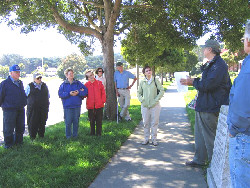 Your Editor [Rt.] Holds Forth at the Rock of the Marne Monument, San Francisco Presidio, Pershing Square in Distance.
Back when the Trip-Wire had 1/3 of its current readership, this was one of our best received features. I thought the new readers would enjoy it as well and you "old timers" might like a revisit.
 Sir Edward Grey, |
 The Annual Wergle Flomp Spoof Poetry Contest First Prize has been awarded to Prof. Alan Farrell of VMI for his wonderful War Poem The Blaming of Parts. It is clever, witty, non-WWI but reminiscent of the best and worst of the Great War's poetry. It is also for ADULTS ONLY, but is still highly recommended by your editor. (read here) 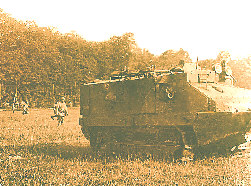 French Schneider Tank |
||||||||||||||||||||
GREAT WAR 2005 | |
|
University of London September 8-9, 2005 (link) | |
|
Seattle, Washington September 16-17, 2005 (link) | |
|
Virginia Military Museum [Full Program Now] Newport News, Virginia September 23-25, 2005 (link) | |
|
International Society for First World War Studies Trinity College, Univ. of Dublin September 23-25, 2005 (link) | |
|
Great War Society Event Veterans Day | |
|
Maryland Military Memorial Baltimore, Maryland November 5, 2005 (link) | |
|
In Flanders Fields Museum Ypres, Belgium November 17-19, 2005 (program) | |
|
Email Response |
|
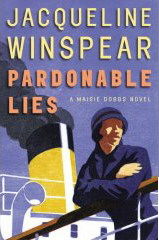
1. Our favorite World War I mystery writer, Jackie Winspear, is on a national autograph signing tour for her latest Masie Dobbs novel Pardonable Lies. She will be in the Bay Area Sept. 15-17. Check at her website for her full schedule. (link)
2. Silicon Valley Alert! A Tuesday Evening WWI Film Festival will start on September 27th at the Dr. King/San Jose State Library. Each documentary will have a knowledgeable facilitator to introduce the film and add commentary. Call 408-808-2093 for more information.
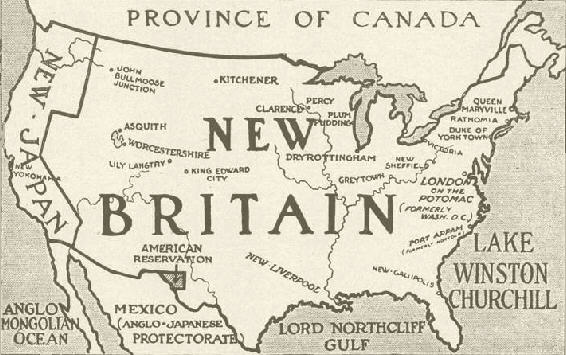
German Propaganda Cartoon from Kriegsbruch Vol. 7
 |
Stars and Stripes Forever in San Francisco
|
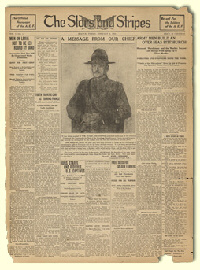 Issue #1 |
Bay Area members and friends might be happy to hear that the San Francisco Public Library has a bound copy of the complete WWI Stars and Stripes, published from February 8, 1918 to June 13, 1919. The volume has the newspapers actual size and is much easier to read than microfilm. The copy was donated to the Library by veteran Felix A. Russo. Russo was a member of Company M, 58th Infantry, Fourth Division. He spent 20 months in Europe, 18 in France and the rest in Germany before coming home. The book is signed and includes Russo's photo. The volume is located in the San Francisco History Center on the 6th Floor. |
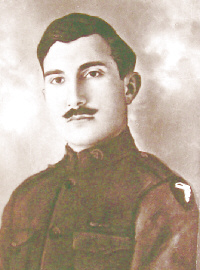 Felix Russo, 58th Infantry |
 |
VauquoisRetracing Mine Warfare in the Meuse-Argonne
|
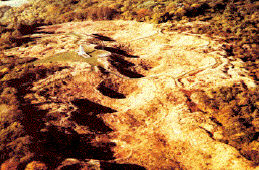 |
By mid-March 1915, opposite trench lines stabilized between the German half of the hill and the French side after the town of 168 inhabitants were evacuated. The villagers would never again see their village at the top of the hill. What followed was a stalemate so intense that it forced both sides to dig down deeper into the hill to seek shelter in tunnels and mine shafts, dug by special military units. Soon, both sides used pioneer and sapper troops to dig tunnels under the enemy lines in order to set off large explosive charges. This became known as the war of mines. Unlike other parts of the Western Front where mine warfare took place, Les Eparges, the Argonne Forest, and Vimy ridge, to name a few, Vauquois unites several factors making this a truly unique site. Vauquois hill became a veritable honeycomb of activity that included underground barracks, operating rooms, command and communication posts, electric air pump stations and even an underground rail station. This is the site of the only village completely destroyed by underground or mine warfare.
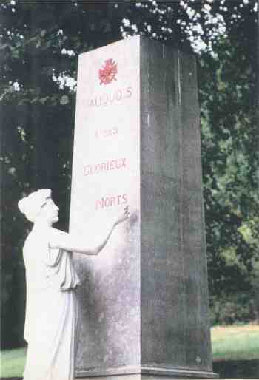 Current Monument |
Guided tours are offered every first Sunday of the month from 9:30 a.m. until 11:00 a.m. Group visits (minimum 10 people) can be arranged by calling the following phone number: 03-29-80-73-15. From Vauquois, it is only a 20-minute drive to the Meuse-Argonne American Cemetery, the largest American military cemetery in Europe with over 14,000 soldiers interred there. To learn more about Vauquois and the nonprofit organization that maintains the site, Les Amis de Vauquois et sa Région, you can visit their website at: http://perso.wanadoo.fr/vauquois.guerre.14.18/. To find out more about the American overseas military cemeteries, maintained and operated by the American Battle Monuments Commission, and the Meuse-Argonne American Cemetery specifically, visit: http://www.abmc.gov/ Meuse-Argonne American Cemetery (Located 40 kilometers northwest of Verdun)
 |
Harvey Weir Cook |
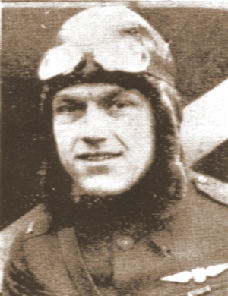 |
"Weir", as he was known, left Washington and Jefferson University to drive an ambulance in France early in 1917. After six months he enlisted in the American Air Service and after training was assigned to the 94th Hat-in-the-Ring Squadron. Incredibly aggressive in combat he was twice cited for singly attacking formations of multiple German fighters. After the war he served as an airmail pilot and with the aviation industry in multiple positions. He had a long affiliation with the Indiana National Guard serving as their air officer.

French 75s at the Marne, September 1914
1914: To Arms covers the events leading to the outbreak of war and the early strategies of the "Battle of the Frontiers" and the "Race for the Sea" by Germany, France and Britain. 1915: Death in Foreign Fields details the ill-fated landings in Turkey, Italy's entry into the war and describes the use of poison gas at Bolimov and the Second Battle of Ypres. 1916: Stalemate relates the slaughter at Verdun and the Somme, the Brusilov Offensive and the Battle of Jutland as the war's carnage and destruction increased to new levels. 1917: The Breaking of Armies recounts the year of mutinies and revolts, and the victories at Vimy Ridge and the Battle of Messines, and the disasters of the Third Battle of Ypres and the Battle of Caporetto. 1918: Germany's Last Gamble begins with the initial German successes with the new "Storm Trooper" tactics in their last great offensives in the war and continues with the first American actions on the Western Front and concludes with the Armistice on November 11th, 1918. Land Warfare Technology offers a look at artillery, machine guns, poison gas and tanks. Air Power Technology looks at the early development of combat aviation from zeppelins to fighters to heavy bombers. Sea Power Technology recounts the advances of naval warfare from 1914 to 1918, detailing the development of the dreadnought, submarine and aircraft carrier that laid the foundations for modern combat at sea. Unfortunately, this series, with its beautifully produced covers and insightful cover notes doesn't work as well as it could. It relies heavily on archival footage and often the same footage is repeated from episode to episode and sometimes within the same episode. The use of maps is sporadic making it difficult to follow the battles. The almost continuous sound effects at times drown out the voice of the detailed and accurate narration. If I had to select the best title of the series it would be Air Power Technology because of the contemporary color footage of existing flying World War I aircraft from the Old Rhinebeck Aerodrome and the Shuttleworth Collection. The narration details the incremental advances made using similar technology and uses both archival footage and the contemporary footage to present a well-done and informative program. I've also been watching the British World War II drama series, Enemy at the Door first broadcast in 1977 and released on DVD by Goldhil Home Media International (www.goldhil.com). After France fell in 1940, the Germans occupied the Channel Islands, the only piece of United Kingdom territory to be occupied by the Nazis during the Second World War. The only Nazi Concentration Camp on British soil was constructed and thousands of the island's inhabitants were interned or deported. Life consisted of starvation, imprisonment and harsh fines for the islanders that remained. Anyone who wonders what a German occupation of Britain would have been like need only look at their Channel Islands occupation. Enemy at the Door details the pain and frustration of the Channel Islands inhabitants during the German occupation. The series is masterfully acted and features authentic Second World War aircraft. The uniforms, weapons and vehicles all seem true to the period. Unlike many other World War II series, Enemy at the Door is not action-packed. Instead, it concentrates on people trying to survive and the moral dilemmas they face while occupied. International Historic Films (www.ihffilm.com) has a DVD documentary, Channel Islands Occupied, on this subject that I recommend. And, what if Germany had invaded and occupied Britain? Take a look at Went The Day Well? from 1942 available from Anchor Bay Entertainment (www.anchorbayentertainment.com). Produced as propaganda during the War it tells how a small British town dealt with German invaders. Or for a more contemporary view, try It Happened Here from 1964. This is masterful independent production about a German occupation after Britain was defeated. It is available from Milestone Film & Video (www.milestonefilms.com) and I highly recommend it and Went The Day Well? Andrew Melomet, Proprietor of Andy's Nickelodeon will answer your Great War film or video inquiry. He is also soliciting your recommendations for the WWI Filmography he is compiling for our readers. Just click HERE. |
| The following are thanked for their contributions to this issue of the Trip Wire: Adam Cohen, Diane Rooney, Susan Neeson, Kurt Schwarz, Donna Cunningham, Herb Stickel, Tom Jones, Tony Langley, Jeffrey Aarnio, Andy Melomet, Len Shurtleff and the Washington Post. Until next month, your editor, Mike Hanlon. |
Membership Information  Click on Icon |
SUBSCRIBE TO THE TRIP-WIRE (Or Send it to a friend.) (Or send us a comment on the TRIP-WIRE) CLICK HERE TO CONTACT US VIA EMAIL |
For further information on the events of 1914-1918
visit the Directory Page of |

